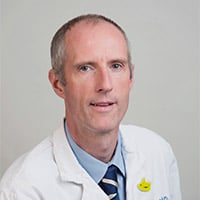
Cushing’s disease continues to confound endocrine clinicians due to the manner in which it mimics more commonplace disorders. We talk to Anthony Heaney, MD, PhD, about his CEU 2021 session, “Challenges in the Management of Cushing’s Disease” and what attendees can expect to learn about this rare endocrine condition.
Cushing’s disease is a rare disorder that can often hide behind more common diseases, manifesting as symptoms of conditions that physicians would first point to as the culprit. It can be a challenge just to diagnose, much less treat. Symptoms of Cushing’s include obesity, hypertension, and depression, all patient complaints that could easily point to any number of things, so if a patient does have Cushing’s, the delay in diagnosis and then treatment only compounds the problem.
 For this year’s Clinical Endocrinology Update (CEU), Anthony Heaney, MD, PhD, associate professor at the David Geffen School of Medicine at the University of California, Los Angeles (UCLA), and an expert in pituitary tumors, will discuss these barriers to optimal treatment of patients with Cushing’s disease during his Meet the Professor presentation, “Challenges in the Management of Cushing’s Disease.”
For this year’s Clinical Endocrinology Update (CEU), Anthony Heaney, MD, PhD, associate professor at the David Geffen School of Medicine at the University of California, Los Angeles (UCLA), and an expert in pituitary tumors, will discuss these barriers to optimal treatment of patients with Cushing’s disease during his Meet the Professor presentation, “Challenges in the Management of Cushing’s Disease.”
Endocrine News caught up with Heaney to hear what to expect from his CEU talk.
Endocrine News: First off, can you give a little background on your presentation, as well as an overview of what attendees can expect?
Anthony Heaney: I plan to use case illustrations to highlight some of the challenges endocrinologists all face in diagnosing and managing a patient with Cushing’s disease.
EN: Your talk is titled “Challenges in the Management of Cushing’s Disease.” Can you give an example or a preview of the challenges that you’ll cover?
AH: As endocrinologists, we face challenges at all stages of Cushing’s disease — the diagnosis can be difficult to make, especially in earlier, less frank cases. Locating the site of disease can sometimes be challenging and the management itself can also be challenging, as although we have some great therapies. They don’t always work and recurrence rates in Cushing’s disease are quite high.
The phenotype that we see in Cushing’s disease is shared with several other conditions that are much more common, and all endocrinologists will encounter patients who might or might not have Cushing’s disease. So, a basic understanding about how to approach such a patient is very helpful to the vast majority of endocrinologists.
EN: Why is it important for physicians to be aware of these challenging cases?
AH: Cushing’s disease is one of those diagnoses that is important to consider, and then based on physician index of suspicion, determine which tests and how much testing is needed to either rule it in or exclude it as a cause for a patient’s symptoms. We know that the phenotype that we see in Cushing’s disease is shared with several other conditions that are much more common, and all endocrinologists will encounter patients who might or might not have Cushing’s disease. So, a basic understanding about how to approach such a patient is very helpful to the vast majority of endocrinologists.
EN: Are there any new techniques or methods you can share for sort of clearing these hurdles of diagnosing or treating Cushing’s?
AH: I wish I could answer that with, “Yes, there have been some major breakthroughs,” but alas, that would be misleading. We have added some new medical therapies which will be helpful, but no breakthroughs that will really change the situation in my opinion just yet.
“Cushing’s disease is one of those diagnoses that is important to consider, and then based on physician index of suspicion, determine which tests and how much testing is needed to either rule it in or exclude it as a cause for a patient’s symptoms.”
EN: What do you hope attendees take away from your talk?
AH: I hope they take away that Cushing’s disease is one of the most challenging conditions that we as endocrinologists diagnose and treat; that there are no perfect algorithms that will easily diagnose every patient; and that a combination of clinical “index of suspicion” and careful, rigorous, and sometimes repeated biochemical testing over time are paramount to helping our patients find help for this disorder.
Bagley is the senior editor of Endocrine News. In the July issue, he wrote the CEU 2021 preview article about the session that details what endocrinologists need to know about fatty liver disease.
The presentation will be a part of the Clinical Endocrinology Update (CEU) 2021, a comprehensive virtual meeting featuring faculty at the forefront of endocrinology describing the latest advances and critical issues in the field.
Taking place September 10 – 12, each day will feature four hours of live programming, including 36 educational sessions spanning seven topics. All sessions will be recorded and available for viewing 72 hours after they conclude.
Information and registration are available at: endocrine.org/ceu2021.



